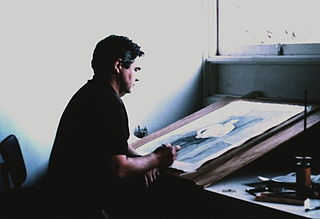
Sydney Parkinson was a Scottish botanical illustrator and natural history artist. He was the first European artist to visit Australia, New Zealand and Tahiti. Parkinson was the first Quaker to visit New Zealand. The standard author abbreviation Parkinson is used to indicate this person as the author when citing a botanical name.
Elizabeth Ann Dewar Churcher was an Australian arts administrator, best known as director of the National Gallery of Australia from 1990 to 1997. She was also a painter in her own right earlier in her life.

John Brack was an Australian painter, and a member of the Antipodeans group. According to one critic, Brack's early works captured the idiosyncrasies of their time "more powerfully and succinctly than any Australian artist before or since. Brack forged the iconography of a decade on canvas as sharply as Barry Humphries did on stage."
Charles Raymond Blackman was an Australian painter, noted for the Schoolgirl, Avonsleigh and Alice in Wonderland series of the 1950s. He was a member of the Antipodeans, a group of Melbourne painters that also included Arthur Boyd, David Boyd, John Brack, Robert Dickerson, John Perceval, and Clifton Pugh. He was married for 27 years to author, essayist, poet, librettist and patron of the arts Barbara Blackman.

Emanuel Phillips Fox was an Australian impressionist painter.
The Heide Circle was a loose grouping of Australian artists who lived and worked at "Heide", a former dairy farm on the Yarra River floodplain at Bulleen, a suburb of Melbourne, counting amongst their number many of Australia's best-known modernist painters.

The Antipodeans were a collective of Australian modern artists, known for their advocacy of figurative art and opposition to abstract expressionism. The group, which included seven painters from Melbourne and art historian Bernard Smith, was active in the late 1950s. Despite staging only a single exhibition in Melbourne in August 1959, the Antipodeans gained international recognition.
Sir Roy Burman Grounds was an Australian architect. His early work included buildings influenced by the Moderne movement of the 1930s, and his later buildings of the 1950s and 1960s, such as the National Gallery of Victoria and the adjacent Victorian Arts Centre, cemented his legacy as a leader in Australian architecture.
Terry Smith is an Australian art historian, art critic and artist who currently lives and works in Pittsburgh, New York and Sydney.
Mike Parr is an Australian performance artist and printmaker and Painter. Parr's works have been exhibited in Australia and internationally, including in Brazil, Cuba, France, Germany, Hungary, Japan, Korea, Taiwan, and the United States.
Ursula Hoff was an Australian scholar and prolific author on art. She enjoyed a long career at the National Gallery of Victoria in Melbourne, where she was deputy director from 1968 to 1973. Her involvement then continued when she was appointed London Adviser of the Felton Bequest (1975–83), a major charitable foundation dedicated to the NGV.
Roslyn Louise "Ros" Pesman, was the first female Challis Professor of History at the University of Sydney and the first woman to be elected chair of the academic board at the university.

Carl Olaf Plate was a prominent Australian modernist painter and collage artist.
The Kate Challis RAKA Award is an arts award worth A$20,000, awarded annually by the University of Melbourne in Victoria, Australia to Indigenous Australian creative artists. It is awarded in a five-year cycle, each year in a different area of the arts: creative prose, drama, the visual arts, script-writing and poetry.
Joan Grounds is an American-born artist. She has been exhibiting in Australia and internationally from 1967. Her solo and collaborative art work is held in the National Gallery of Australia (ceramics), the National Gallery of Victoria and in the Powerhouse Museum of Arts and Applied Sciences (ceramics). Her hybrid practice incorporated ceramics, sculpture, sound art, film and performance art.

The Field was the inaugural exhibition at the National Gallery of Victoria’s new premises on St Kilda Road, Melbourne. Launched by the director of London’s Tate gallery, Norman Reid, before an audience of 1,000 invitees, it was held between held 21 August and 28 September 1968. Hailed then, and regarded since as a landmark exhibition in Australian art history, it presented the first comprehensive display of colour field painting and abstract sculpture in the country in a radical presentation, between silver foil–covered walls and under geometric light fittings, of 74 works by 40 artists. All practised hard-edge, geometric, colour and flat abstraction, often in novel media including coloured or transparent plastic, fluorescent acrylic paints, steel and chrome. The art was appropriate to a launch of the new venue itself, designed by architect Roy Grounds, and emphatically rectilinear; cubes nested in a basalt rectangular box amongst the other buildings of the new Arts Centre, each based on a geometric solid. Echoing emerging international stylistic tendencies of the time, The Field sparked immediate controversy and launched the careers of a new generation of Australian artists.
Professor Nancy Underhill is an art historian, curator, lecturer and author. She is the Founder of the University of Queensland Department of Art History.
Jacqueline Hick was an Australian painter whose work is held in the permanent collections of multiple museums in Australia. She is known for her work depicting human figures and the Australian landscape. She is the subject of the 2013 book Jacqueline Hick: Born Wise.
Paul Giles is an English-born academic, author and researcher. He is a Professor of English in the Institute for Humanities and Social Sciences at the Australian Catholic University in Melbourne. He is also an Honorary Professor at the University of Sydney.
The Tin Sheds was the common name of the Sydney University Art Workshop, an Australian art workshop in Sydney, New South Wales, founded in 1969. Its name lives on in the Tin Sheds Gallery at the University of Sydney School of Architecture, Design and Planning. Groups such as Optronic Kinetics and the Earthworks Poster Collective operated out of Tin Sheds.






